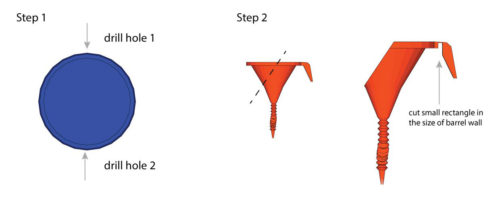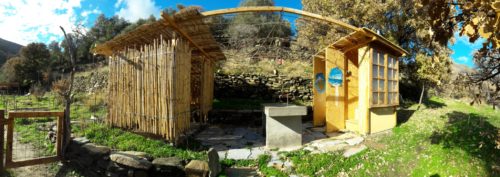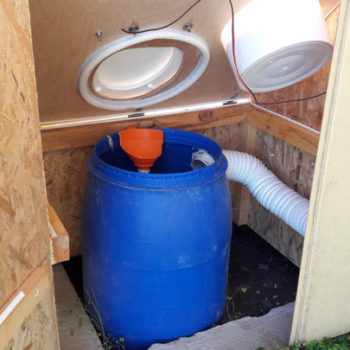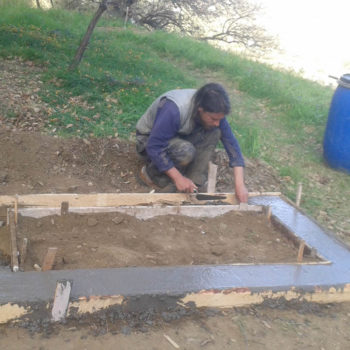Barrel Compost Toilets
In 2016 the Ecolodge expanded its outdoor infrastructure by building the garden kitchen and oven, outdoor showers and compost toilets in order to be able to host seminars and people that camp on the ground. We hosted our first Permaculture seminar in September 2016 and all this infrastructure was tested and used by 27 people that were gathered here for 11 days! So we have our first results on how everything worked. This article aims to show how to build an outdoor compost toilet and encourage others to use this green technology which is the best solution to sustainable sewage treatment!
Why compost toilets
The type of compost toilets that we decided to build was a simple closed system that consists of a portable 120 liter barrel that would be able to change when full and keep it aside to rest for the solids to decompose. The reason is that the compost toilets are not used constantly but only at periods when we host seminars (3-4 times a year) and randomly when we host friends that camp, so there is no heavy pressure all the time. The extra tip on the system was to apply a separator for the urine that goes to a septic tank with leachfield. But before entering into the construction details let’s talk a little about the pros of compost toilets!
- We don’t pollute the water resources. With compost toilets the solid waste is dealt with on site and do not end up into rivers or allows liquids to soak into the surrounding soil and thus reaching and polluting the aquifer. In Tinos is even more important as there is no mains sewerage system and usually independent houses built a cesspool that is emptied by a tanker when its full, although some older ones allow liquids to soak into the surrounding soil.
- We save water. Normal toilets with 12lt flush would use up to 48 liters a day per person of fresh drinkable water for flushing down the …shit! A normal family of 4 would use 192 liters per day or 70,080 lt per year!!! Low flush toilets are already in the market, we use ones in the houses with 2-4lt low-high flush. Water shortage is already a serious problem in Tinos and the Cyclades islands, compost toilets win against all other systems as they use no water at all!
- We create compost for soil improvement. It’s interesting that: If an individual wanted to be self-sufficient in food the nutrients in that persons urine and faeces, together with the composted waste from the previous year’s crops, would be more than enough to provide all of his or her food.
- Other benefits include no chemical cleaners or bleaches, no sewage sludge problem, no greenhouse gas emissions, saving energy, very low overall resource use and saving money!
Basic design of our compost toilets

Here we present a step by step guide to build your own outdoor compost toilets.
We built two toilets, one next to the other, combined with outdoor showers and sink near the vegetable garden at the back of the plot. First we built a concrete ring foundation and dug the inside area 50cm deep for the barrels to be placed without having to go too high with the toilet seat and the whole building. We decided to use 120 liter plastic barrels the ones used for food storage which have enough capacity and can be easily removed and replaced when they get full. The most challenging part was how to separate the urine from the solids which is very important in the compost procedure. Since the toilets were going to be used from the ladies also to wee it was essential to find a solution otherwise too much liquid in the barrel will cause the system to become anaerobic, resulting in some pretty nasty smells! Its easier for men to get them to wee somewhere else, a straw-bale was the perfect solution during the seminar.
So after some research and trial and error with different funnels we used a plastic funnel of 16cm diameter that had a flexible spiral at the end of it that was connected to a 40mm pvc drainage pipe that was discharged at a nearby leachfield. The funnel was hanged at the barrel top and was cut from one side to give more opening for the urine to find its target!
DIY How to
Drill two holes through the barrel. Hole 1. will be connected to the funnel that will divert the urine. We used a 12mm flange for irrigation pipes.

Hole 2. will be connected to the ventilation pipe. We used an endcup for 75mm PVC plumbing pipes that comes with a screwable top in order to seal the full barrel after use.
The funnel should be out of plastic that can be cut. In our test a diameter of 160mm had the best size. Cut away the piece indicated in the drawings, so that there is enough room in the barrel that faeces can fall freely without coming in contact with the funnel.
Place the flange and tighten it. Use some plumbing tape to get a tight fitting to the funnel pipe. But do not glue the two pieces together because you want to swap the funnel to the next barrel. Place the funnel with its handle on the barrel wall and check connection. Place the funnel acording to the drawing below.
Place the PVC endcup into the hole and glue it with silicone to the barrel. Do that from the inside and the outside so you achieve a strong adhesion between the to parts.Cut a piece of the flexible ventilation pipe long enough to reach the PVC pipe. Just put them together so you can easily loosen the connection again. Cut a piece of irrigation tube in order to connect it to the 40mm PVC pipe. This pipe is leading the urine away.

Maintenance
Both toilet chambers have back doors to remove and change the barrels. The whole platform with the seat is lifted and the barrels are easily removed. The seat is a wooden toilet seat. The underside of the seat is sealed with a ring of draughtproof strip to keep smells in and flies out, alternatively you can use silicon. The same has to be applied on the toilet lid, and the lid has to remain closed at all times when not in use. Another useful thing to add is a fly trap, something that we didn’t do but will add. A simple jar fixed upside down on the platform that contains a cone inside for the flies to enter and not exit.
Compose / Decompose
Now, how to create compost, everytime the toilet is used the paper goes inside the barrel and in the end we add a handful of sawdust. A bucket full of sawdust is always next to the toilet. This is done in order to create a desirable carbon-nitrogen ratio for the bacteria to eat waste. Human waste contains too much nitrogen so we add soaks which are carbon rich materials. Other carbon rich material that can be used is straw and hay, shredded paper, compost or soil, lime or wood ash (although wood ash contains salts that can kill useful micro organisms, so it’s good to add only to eliminate smells if necessary). After the barrel is full we take it out and leave it to rest in a sunny place for a year while its contents decompose and become compost.
Pictures of the construction
Here is a small step by step photo series that shows the construction of the clearing and leveling the ground, framing for the foundation, building the enclosure, cutting and sanding the holes and some extras we put: the little green house on the site for raising seedlings
Credits:
Text : Marilia Kalouli
Illustration : Nicolas Bedau
Resources:
a lot of inspiration for our system came from Davis Omicks website that has plenty of information about compost toilets: http://www.omick.net/composting_toilets/barrel_toilet.htm
Dave Darbys book “compost toilets a practical, DIY guide” ISBN 978-0-9566751-1-8
Sustainable Sanitation Alliance (SuSanA) has maybe the most complete database on the Ecological sanitation (ecosan) approach http://www.susana.org/en/
http://www.ecosan.org/ which holds some useful information but is not updated anymore
The world bank has also some nice documentations under http://water.worldbank.org/shw-resource-guide/infrastructure/menu-technical-options/ecological-toilets
If you have any suggestions, questions or improvements just post a comment below
































Leave a comment